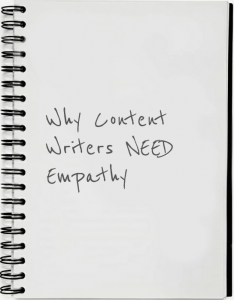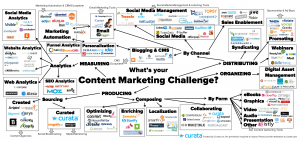What are the most important skills a content writer needs? Some of the obvious answers that may first come to mind are:
- Knack for language
- Ability to research
- Understanding of how to format content for the web
- Ability to write easy-to-read content
- Ability to create a content calendar and stick with deadlines
The two answers that came up the most often when I asked content strategists what skills the best content writers possessed were creativity and curiosity.
All of that matters. Good content writing requires a pretty significant skillset. But nothing on that list would be enough to create compelling content that people want to read without the skill that’s arguably most important of all: empathy. You probably won’t see it show up on a resume or the list of qualifications in a job ad, but without empathy, nothing a content writer produces will resonate with the target audience.
The Case for Empathy in Content Marketing
Marketers talk a lot about how important empathy is, but often in other terms. How many times have you heard your marketing colleagues use the phrase “know your audience.” It’s an easy thing to say, but empathy can actually be really challenging. It’s not something that’s taught in school. Most businesses don’t exactly cover it in their training. Trying to truly understand what someone else is thinking and feeling is difficult.
Our default mode is to view our own perception of the world as the most obvious, natural way to see things. It’s just how we’re wired. Getting outside of our own heads in order to figure out the differences in how others see things takes effort and practice.
No one’s arguing against empathy in marketing, but not many organizations are putting it front and center. Probably in large part because it is so much harder than it looks. It’s easy enough to think you know your audience, but much harder to actually go the extra mile to really understand them.
How Can Someone Get Better At Empathy?
 That poses the question: what can we actually do about it? First and foremost, read.
That poses the question: what can we actually do about it? First and foremost, read.
If there’s one main way to flex our brain’s empathy muscle, it’s to get inside the heads of other people through books, short stories, and articles. Fiction and non-fiction are both good for this. Through reading, you can take a ride through the mindset and perceptions of the writer or character and learn about the experiences of others.
Devoting more time to reading is great advice for anyone who cares about becoming empathetic (or becoming a better writer in any format). But there’s a whole set of other steps you can take to become more empathetic to your particular audience.
Find them online. Then just hang out and listen.
Look for forums, social media groups, and blog comment sections where your audience hangs out. There are so many spaces online today where people share their thoughts and feelings, if you can figure out where those spaces are for your audience then you’ll have an easy glimpse into the kinds of questions and concerns they have.
Talk to your salespeople and customer service reps.
There are people within your company working directly with your customers and prospects every day. Your salespeople and customer service representatives hear first hand what your target audience is thinking about, the issues they’re facing, the questions they commonly have and the kinds of problems they regularly deal with. All of that information can help you understand your audience better and craft your content calendar based on the topics they actually care about.
Look to your data.
Marketers have more data today than they ever have in the history of the profession. You likely already have at your fingertips loads of information on what your prospects are searching for, the terms they use, and the types of content they’re most commonly seeking out. Data can seem dry and impersonal, but with the proper analysis, it can provide content writers with important insights into the minds of your prospects.
Revisit and refine your personas semi-regularly.
Personas shouldn’t be a project you tackle once and then leave alone. You’re constantly learning more about your audience – what issues they care about, what types of content they respond to, what topics they’re discussing online – your new insights should make their way into the personas you have. Commit to revisiting your personas at least once or twice a year to improve upon them based on new information.
Empathy is a crucial skill to have as a content writer, but more importantly, it helps people to become better human beings. When you make an effort to understand what other people go through and how they feel, becoming better at communicating and treating people with greater compassion are natural side effects. The same skill that will make your content more relatable and successful will pay off in your life far beyond the effects it has on your work.






